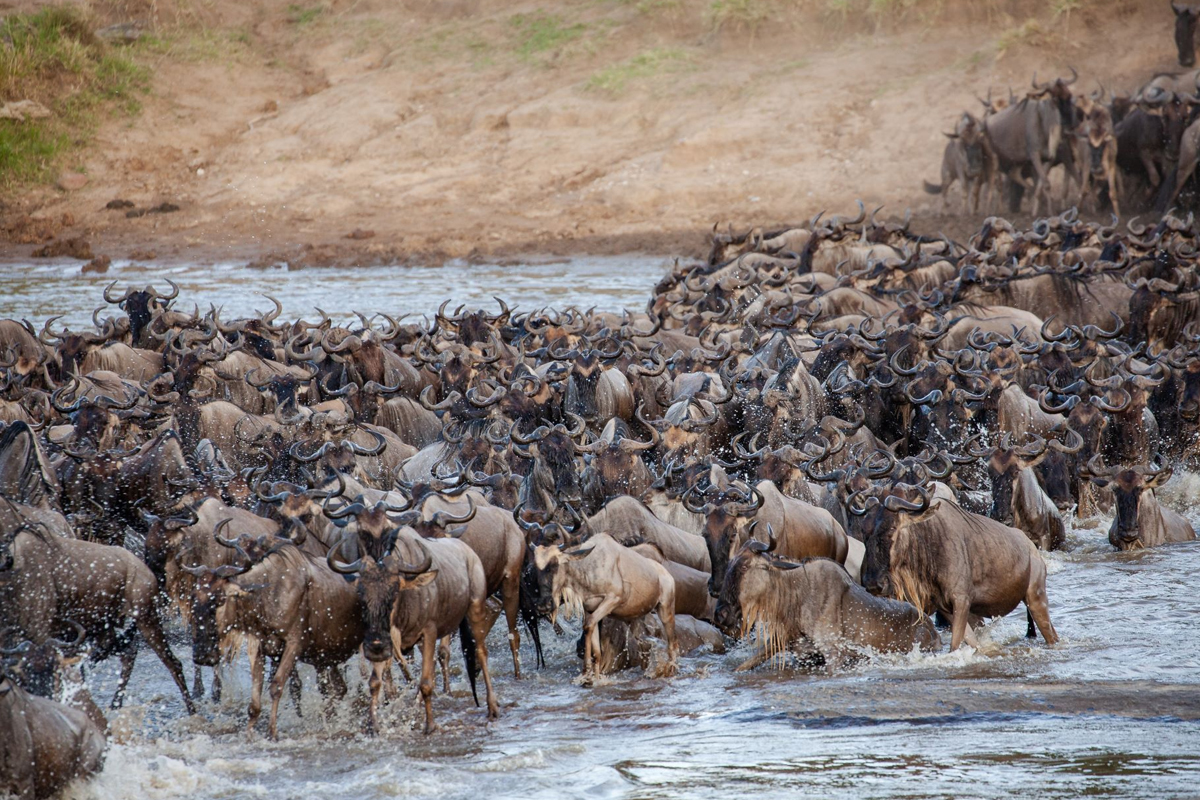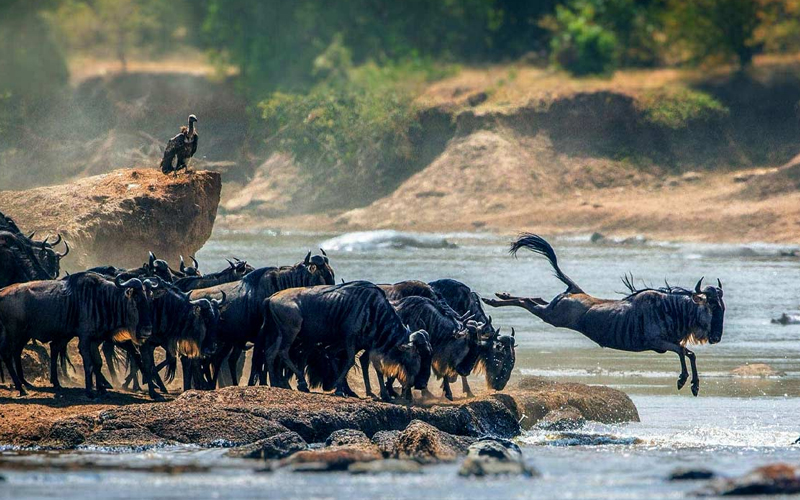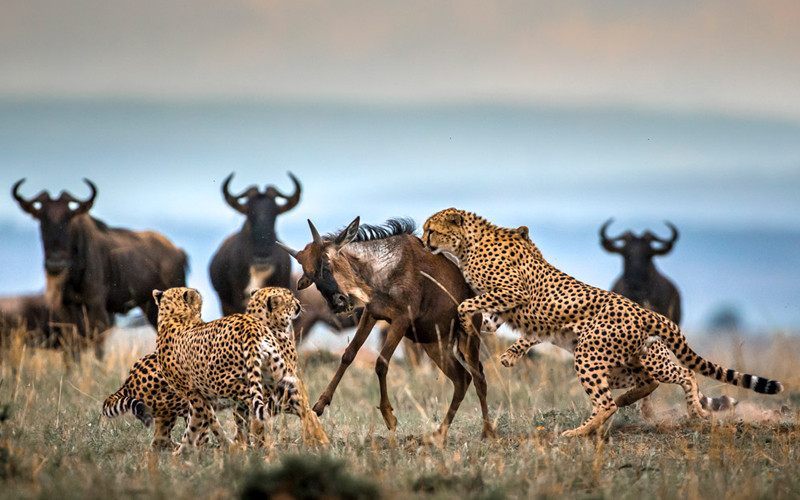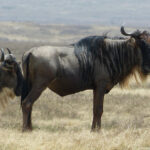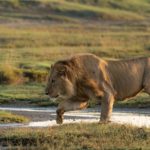The wildebeest migration is one of nature’s grandest spectacles, showcasing the immense beauty and complexity of the animal kingdom. Central to this event are the various herbivores that traverse the Serengeti-Mara ecosystem. These herbivores play critical roles in maintaining ecological balance and biodiversity, making their migration a topic of great interest and importance.
Overview of the Wildebeest Migration
The Great Migration involves over a million wildebeest, accompanied by hundreds of thousands of zebras and gazelles, moving across the Serengeti and Maasai Mara in search of fresh grazing grounds. This annual journey covers approximately 1,800 miles and is driven by the seasonal rains that replenish the grasslands. The migration not only sustains the herbivores but also supports a myriad of predators and scavengers, making it a cornerstone of the region’s ecosystem.
Wildebeest: The Central Players
Wildebeest, also known as gnus, are the primary participants in the migration. These large, sturdy antelopes are renowned for their mass movement, which creates one of the most dynamic natural events on Earth. With their numbers exceeding 1.5 million, wildebeest play a crucial role in shaping the landscape through their grazing habits and by providing a significant food source for predators.
Zebras: The Striped Companions
Zebras are essential companions in the wildebeest migration. These distinctive, striped herbivores often travel with the wildebeest, benefiting from the safety in numbers. Zebras tend to graze on the longer grasses, which clears the way for wildebeest to feed on the shorter, more nutritious grasses that follow. This symbiotic relationship helps both species thrive during the long journey.
Gazelles: The Graceful Travelers
Gazelles, particularly Thomson’s and Grant’s gazelles, are also key participants in the migration. Known for their speed and agility, these graceful animals add to the diversity of the migrating herds. Gazelles often follow similar migration routes as wildebeest and zebras, utilizing the fresh pastures left behind by the larger herbivores.
Eland: The Largest Antelopes
Eland is the largest antelope in the migration. These massive herbivores are less numerous but still play a vital role in the ecosystem. Eland migrate to find better grazing and breeding grounds, contributing to the overall dynamics of the migration.
Thomson’s Gazelle: The Agile Movers
Thomson’s gazelles, known for their agility and speed, are smaller but no less important in the migration. They often stay on the fringes of the larger herds, benefiting from the protection and resources these groups provide. Their survival strategies include rapid acceleration to escape predators and highly alert behaviors to detect threats.
Grant’s Gazelle: The Robust Wanderers
Grant’s gazelles are slightly larger than Thomson’s gazelles and more robust in their build. They migrate alongside other herbivores, utilizing similar routes and grazing areas. These gazelles are known for their endurance and ability to thrive in various environments, making them resilient participants in the migration.
Topi: The Swift Grazers
Topis are known for their swiftness and are another important herbivore in the migration. They are highly efficient grazers, moving quickly through the grasslands to find fresh pastures. Topics contribute to the balance of the ecosystem by maintaining grassland health and providing a food source for predators.
Impala: The Elegant Leapers
Impalas, with their slender build and impressive leaping abilities, are also part of the migrating herbivores. Although they do not travel in as large groups as wildebeest or zebras, their presence adds to the ecological diversity of the migration. Impalas play a significant role in the food chain, supporting both predators and the health of the grasslands.
Ecological Impact of Herbivores
Herbivores significantly impact the ecosystem through their grazing patterns. Their movement across the plains helps maintain the health of grasslands by preventing overgrowth and encouraging new plant growth. This grazing activity promotes soil health and supports a wide range of plant and animal species, contributing to overall biodiversity.
Predator-Prey Dynamics
Herbivores are a crucial part of the food chain, supporting a variety of predators such as lions, hyenas, cheetahs, and crocodiles. The presence of these predators creates a dynamic balance, where both predator and prey populations are kept in check. Herbivores have developed numerous adaptive behaviors to evade predators, including traveling in large herds and being highly vigilant.
Human Influence on Herbivore Populations
Human activities, such as agriculture, urbanization, and poaching, pose significant threats to herbivore populations. Habitat destruction reduces the available grazing areas while poaching directly decreases animal numbers. Conservation efforts are essential to protect these species and ensure the continuation of the migration. Climate change also impacts migration patterns by altering rainfall patterns and resource availability.
Conservation and Future of the Migration
Conserving the migration requires protecting migration corridors, reducing human-wildlife conflict, and supporting anti-poaching measures. Conservation programs focus on maintaining the health of both herbivore and predator populations. Ecotourism can play a positive role by providing funding for conservation efforts and raising awareness about the importance of protecting these natural wonders.
Herbivores are the heart of the wildebeest migration, driving the ecological processes that sustain the Serengeti-Mara ecosystem. Their migration is a testament to the intricate balance of nature, highlighting the importance of preserving these majestic animals and their habitats. Conservation efforts are crucial to ensure that this extraordinary natural phenomenon continues for future generations to witness and appreciate.
FAQs
What are the primary herbivores in the wildebeest migration? The primary herbivores include wildebeest, zebras, Thomson’s gazelles, Grant’s gazelles, eland, topi, and impalas.
How do zebras and wildebeest benefit each other during migration? Zebras and wildebeest benefit from each other through complementary grazing habits and mutual protection from predators, enhancing their chances of survival.
Why is the wildebeest migration important for the ecosystem? The migration maintains grassland health, supports predator populations, promotes biodiversity, and ensures the survival and genetic diversity of migrating herbivores.
What challenges do migrating herbivores face? Migrating herbivores face challenges such as predation, river crossings, habitat destruction, climate change, and human activities like poaching.
How can individuals help in the conservation of migration? Individuals can support conservation efforts through donations, responsible ecotourism, spreading awareness, and supporting policies that protect wildlife and their habitats.
Explore Tanzania’s beautiful national parks, from the famous Serengeti, where you can see the amazing wildlife migration, to the stunning Ngorongoro Crater, full of diverse animals. Visit Tarangire National Park, known for its large elephant herds, and climb the majestic Kilimanjaro, Africa’s highest peak. Relax on the pristine beaches of Zanzibar, and you can also volunteer and make a difference during your trip. Join us for an unforgettable Tanzania Safari tour!

